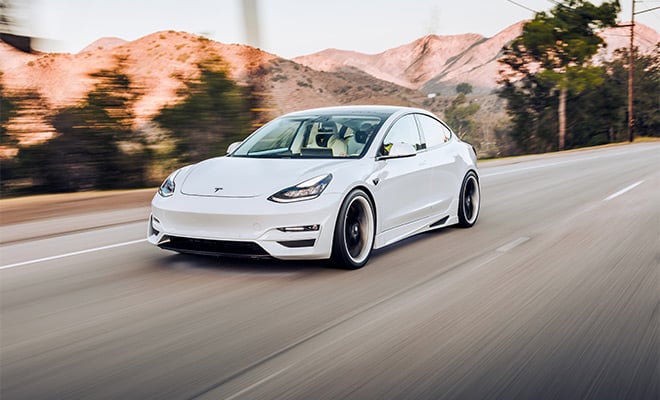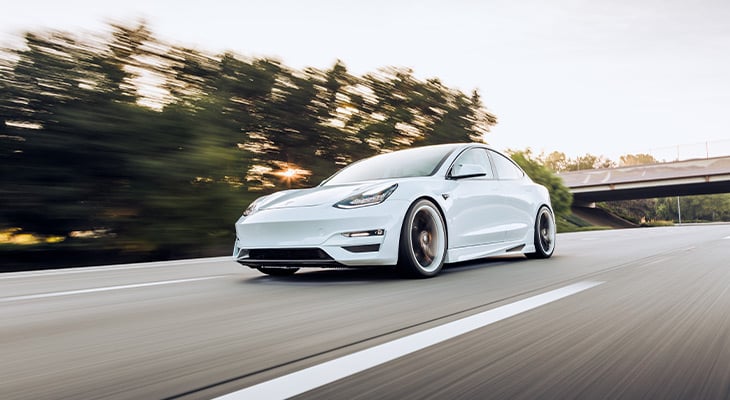Breaking Down Why Teslas Cost So Much to Insure
Why You Can Trust Compare.com 
At Compare.com, it’s our mission to find simple ways to help our customers save money on the things they need. While we partner with some of the companies and brands we talk about in our articles, all of our content is written and reviewed by our independent editorial team and never influenced by our partnerships. Learn about how we make money, review our editorial standards, and reference our data methodology to learn more about why you can trust Compare.com.
Teslas — with their cutting-edge technology and impressive real-world performance — stand out in the auto world. Some — like the Model 3 — are even competitively priced compared to similar cars. But owning one comes with an extra cost — higher insurance premiums.
Many luxury cars cost more to insure simply because of their higher price tag. But the reason Tesla insurance is so high has less to do with luxury than with practical factors, like the high repair costs, lack of aftermarket parts, and a lower threshold for declaring the vehicle totaled.
Let’s explore the average Tesla insurance cost, how it measures up to premiums for other vehicles, and a few strategies to lower your rates.
Get Cheaper Rates for Your Tesla in Minutes
The Average Cost to Insure a Tesla
| Liability Only | Full Coverage |
|---|---|
| $120 | $329 |
Insuring a Tesla isn’t like insuring most other vehicles. On average, liability insurance runs $120 per month, while a full-coverage policy hovers around $329, according to Compare.com data. Besides the expensive repair costs, limited part availability, exclusive repair network, and higher car values, the sheer power they deliver makes them riskier to insure.
Consider the Model S as an example. Tesla’s website claims it’s “built for speed” with “improved aerodynamics … so you can take corners quicker and with more confidence.” With a description like that, it’s no surprise insurance companies charge more for coverage.
Tesla insurance costs vs. other cars
The difference is stark if you compare the average cost of auto insurance for Teslas to other cars. In fact, Tesla owners pay 59% more than the national average car insurance bill, according to Compare.com data.
The table below shows what the average driver can expect to pay for each Tesla model, as well as how their rates compare to the national average for all vehicles.
| Model | Average Monthly Premium | Compared to National Average |
|---|---|---|
| Tesla Model S | $215 | +45% |
| Tesla Model X | $207 | +40% |
| Tesla Model 3 | $251 | +70% |
| Tesla Model Y | $213 | +44% |
| All Teslas | $235 | +59% |
Our research paints a clear picture: insuring a Tesla is substantially more expensive than other vehicles. But just how much more expensive depends on the model you buy. For instance, the Model X is the cheapest Tesla to insure. Still, it has an average monthly cost of $207, making it 40% more expensive than the national average.
The Model 3 is on the opposite end of the spectrum. Insurance for the Model 3 has an average price tag of $251 — 70% more than comparable car insurance coverage.
You’re probably wondering why Tesla insurance is so high. We’ll explore the reasons in the next section.
5 Reasons Why Tesla Insurance Is So Expensive
As we’ve covered, the distinction of driving a Tesla — with its fusion of luxury and technology — comes with higher costs for insurance. While the brand’s cutting-edge features and eye-watering performance are appealing to many drivers, they also contribute to steeper insurance premiums. But that’s only part of the story behind large Tesla insurance prices.
Let’s break down why Teslas cost so much more to insure than other vehicles.
Higher vehicle values
Teslas, like other luxury cars, have a higher market value — and that directly influences car insurance rates. Insurers assess the cost of replacing or repairing your vehicle if it gets in an accident — and with Tesla’s higher sticker price, the insurance premiums naturally rise to cover these potential costs.
Higher repair costs
Electric vehicles (EVs) are cheaper to drive and maintain, according to the U.S. Department of Energy, but repairs can be more expensive if you have to file an insurance claim. This is especially true for Tesla vehicles.
The average non-Tesla EV repair costs $4,474 — $269 more than a traditional internal combustion engine (ICE) vehicle, according to Mitchell, a company that provides software for insurers and repair shops. But the average Tesla repair jumps more than $1,000 to $5,552.
Limited parts availability
Tesla is a relatively new manufacturer that doesn’t benefit from the same kinds of large-scale production and distribution systems as traditional car companies. This smaller footprint leads to challenges in parts availability, a factor that affects claim repair times. This scarcity also increases the cost of parts, which insurers also consider when setting premiums.
Exclusive repair network
As a Tesla owner, you have access to a proprietary repair network that sets high standards for its technicians. Tesla operates all of its own service centers, which can translate to a high-end experience and quality repairs. But limited options and no access to aftermarket parts (Tesla-approved service centers use only original Tesla parts) make finding a repair shop a difficult task — especially if you don’t live in a big metropolitan area.
Potential damages
Electric cars have heavier batteries and quicker acceleration than regular cars, which can lead to more severe damage in collisions. It comes down to Einstein’s often-quoted theory of relativity: E = mc2 (energy equals mass times acceleration).
For example, the 2024 Tesla Model X Plaid weighs 5,248 lbs. and accelerates from 0 to 60 mph in a staggering 2.5 seconds. That’s a lot of energy, especially compared to the average SUV. That potential energy increases risk and, consequently, insurance costs.
How Tesla Uses “Real-Time Driving Behavior” to Calculate Your Rates
Insurance companies using driving behavior to calculate premiums isn’t a new idea — insurers have used telematics programs that track how you drive for nearly three decades.
But Tesla takes a unique approach. It has an in-house insurance program that doesn’t require you to connect an additional device or download a smartphone app to collect and track how you drive. Specifically, when calculating premiums, Tesla Insurance considers your:
- How you drive
- How often and how far you drive
- Your vehicle model
- Where you live
- Your coverage levels
It also bases your rates on how many vehicles you insure. Keep in mind that Tesla’s “real-time driving behavior” isn’t available nationwide. As of early 2024, it’s available in only 11 states.
How to Get Cheaper Tesla Insurance
Despite Tesla’s higher prices, you can use a few different strategies to help you reduce your car insurance premiums. EVs have advanced safety features, which can contribute to lower rates. In addition, knowing the factors insurance companies consider when pricing policies can help you make cost-effective decisions.
Here are some key tips to help you get cheaper Tesla insurance rates:
- Increase your deductible: Opting for a higher deductible can lower your monthly premiums. Just make sure it’s an amount you can comfortably afford in case of an accident.
- Look for low-mileage discounts: If you don’t drive your Tesla very often, you might be eligible for a low-mileage discount for clocking in fewer miles.
- Ask about discounts: Besides safety feature discounts, you may qualify for savings if you insure more than one vehicle, have a clean driving record, or take a defensive driving course.
- Compare different insurance quotes: Always compare quotes from multiple insurance Each insurer has its own way of assessing risk and pricing policies, so shopping around can help you find the best deal for coverage.
Get Cheaper Tesla Insurance in Minutes
3 Cheapest Tesla Insurers
If you’re asking why Tesla insurance is so high, you’re probably also on the hunt for a more affordable insurance policy. The table below highlights three insurance companies offering some of the cheapest rates for Teslas, as well as how each compares to the national average for these vehicles.
| Insurance Company | Average Monthly Premium | Average Monthly Savings* |
|---|---|---|
| Mercury | $169 | $66 |
| Liberty Mutual | $176 | $59 |
| The General | $214 | $21 |
| *Average savings are calculated based on the difference between each insurer’s average rates for Teslas and the national average rate for these vehicles. | ||
Mercury stands out as the most economical option, offering an average monthly cost of $169. This makes it the cheapest car insurance on the list and allows the average driver to cut $66 off their insurance bill — saving nearly $800 per year.
That said, insurance companies look at a wide range of factors when determining your rates, and since no two drivers are the same, rates can vary dramatically from one driver to the next. That means researching and comparing car insurance rates is crucial when looking for more affordable premiums for your Tesla.
Tesla Insurance Costs FAQs
As we’ve covered, many variables go into calculating Tesla insurance costs. To help you better understand and manage the expense, here are some answers to commonly asked questions about insuring Teslas.
Why are Teslas difficult to insure?
Teslas are difficult to insure mainly because of high repair costs and limited parts availability. The scarcity and expense of Tesla-specific parts — and the need to use a Tesla-approved service center — elevate insurance costs.
How can you reduce Tesla insurance costs?
To reduce Tesla insurance costs, start with a few simple strategies, such as shopping around to compare quotes from different insurers. You can also increase your deductible and ask about discounts to lower your premiums further.
Is the Tesla Model Y expensive to insure?
The Tesla Model Y is more expensive to insure than the average car, but it’s relatively affordable compared to other Tesla models. The average rate is 44% higher than the national average for a traditional vehicle, but it’s still nearly 10% cheaper to insure than the average Tesla, according to Compare.com data.
How does Tesla Insurance calculate rates?
Tesla Insurance calculates rates using what it calls “real-time driving behavior.” This includes factors like driving habits, time spent on the road, vehicle model, ZIP code, and coverage level. This approach gives you a more personalized risk assessment, potentially lowering premiums if you drive your Tesla safely.
Methodology
Data scientists at Compare.com analyzed more than 50 million real-time auto insurance rates from more than 75 partner insurance providers in order to compile the quotes and statistics seen in this article. Compare.com’s auto insurance data includes coverage analysis and details on drivers’ vehicles, driving records, insurance histories, and demographic information.
All the quotes listed in this article have been gathered from a combination of real Compare.com quotes and external insurance rate data gathered in collaboration with Quadrant Information Services. Compare.com uses these observations to provide drivers with insight into how auto insurance companies determine their premiums.
Sources
- The U.S. Department of Energy, “Saving Money with Electric Vehicles,” Accessed March 4, 2024.
- Kelley Blue Book, “Study: Apart from Tesla, EV Repairs Not Much More Costly,” Access March 4, 2024.
- CNBC, “Tesla owns its service centers — a unique business model that may be reaching its limit,” Accessed March 4, 2024.
- Bloomberg Law, “Tesla Monopoly on Repairs, Parts Gouges Car Owners, Suits Say,” Accessed March 4, 2024.
- Tesla, “Tesla Insurance Using Real-Time Driving Behavior,” Accessed March 4, 2024.
Compare Car Insurance Quotes
About Compare.com
Compare.com’s #1 goal is to save you money. We publish resources that are based on hard-hitting data and years of industry experience to help you make more informed decisions with your wallet.
- All of Compare.com’s content is written and reviewed for accuracy by a team of experienced writers and editors who are experts on the topics they cover.
- None of Compare.com’s content is ever influenced by the companies and brands we partner with.
- Compare.com’s editorial team operates independently of any of the company’s partnership or business development interests. We publish unbiased information strictly for the benefit of our readers.
- All of the content you see on Compare.com is based on comprehensive analysis and all data is gathered and vetted from trustworthy sources.
Learn more about us, our team, and what makes us tick.









